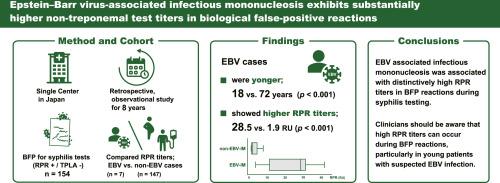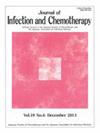爱泼斯坦-巴尔病毒相关的传染性单核细胞增多症在生物学假阳性反应中显示出明显更高的非螺旋体检测滴度
IF 1.5
4区 医学
Q3 INFECTIOUS DISEASES
引用次数: 0
摘要
目的快速血浆反应素(RPR)检测中生物学假阳性(BFP)反应使梅毒筛查解释复杂化。虽然eb病毒相关的传染性单核细胞增多症(EBV-IM)是已知的BFP反应的原因,但这种情况下的RPR滴度特征仍不清楚。本研究旨在比较EBV-IM患者和其他基础疾病患者BFP反应的RPR滴度。方法回顾性分析2016年4月至2024年3月在日本某社区医院进行的梅毒螺旋体血凝试验(TPLA)和RPR检测结果。BFP反应定义为RPR阳性和TPLA阴性。比较EBV-IM与其他原因引起的BFP反应的临床特征和RPR滴度。结果在154例BFP确诊病例中,EBV-IM病例(n = 7)的RPR滴度显著高于其他基础疾病(n = 147)(中位数28.5相对单位[RU],四分位数间距[IQR]: 11.2-31.2 vs. 1.9 RU, IQR: 1.2-4.3, p <;0.001),尽管年龄明显年轻(中位年龄18岁,IQR: 17.4-25 vs. 72岁,IQR, 44.5-82, p <;0.001)。在所有BFP病例中,肿瘤是最常见的基础疾病(22.1%),其次是消化系统疾病(8.4%)和传染病(7.8%)。结论sebv - im在BFP反应中具有明显的高RPR滴度,而在其他条件下具有典型的低滴度。临床医生应该意识到,在BFP反应期间可能出现高RPR滴度,特别是在疑似EBV感染的年轻患者中。本文章由计算机程序翻译,如有差异,请以英文原文为准。

Epstein–Barr virus-associated infectious mononucleosis exhibits substantially higher non-treponemal test titers in biological false-positive reactions
Objectives
Biological false-positive (BFP) reactions in rapid plasma reagin (RPR) tests can complicate syphilis screening interpretation. Although Epstein–Barr virus-associated infectious mononucleosis (EBV-IM) is a known cause of BFP reactions, the characteristics of RPR titers in such cases remain unclear. This study aimed to compare the RPR titers in BFP reactions between patients with EBV-IM and those with other underlying conditions.
Methods
We retrospectively analyzed the RPR and Treponema pallidum hemagglutination assay (TPLA) results of all tests performed at a community hospital in Japan between April 2016 and March 2024. BFP reactions were defined as positive RPR and negative TPLA results. Clinical characteristics and RPR titers were compared between EBV-IM and other causes of BFP reactions.
Results
Among 154 confirmed BFP cases, EBV-IM cases (n = 7) showed significantly higher RPR titers than other underlying conditions (n = 147) (median 28.5 relative units [RU], interquartile range [IQR]: 11.2–31.2 vs. 1.9 RU, IQR: 1.2–4.3, p < 0.001), despite a significantly younger age (median age 18 years, IQR: 17.4–25 vs. 72 years, IQR, 44.5–82, p < 0.001). Among all BFP cases, neoplasms were the most common underlying condition (22.1 %), followed by digestive diseases (8.4 %) and infectious diseases (7.8 %).
Conclusions
EBV-IM is associated with distinctively high RPR titers in BFP reactions, in contrast to the typically low titers observed under other conditions. Clinicians should be aware that high RPR titers can occur during BFP reactions, particularly in young patients with suspected EBV infection.
求助全文
通过发布文献求助,成功后即可免费获取论文全文。
去求助
来源期刊

Journal of Infection and Chemotherapy
INFECTIOUS DISEASES-PHARMACOLOGY & PHARMACY
CiteScore
4.10
自引率
4.50%
发文量
303
审稿时长
47 days
期刊介绍:
The Journal of Infection and Chemotherapy (JIC) — official journal of the Japanese Society of Chemotherapy and The Japanese Association for Infectious Diseases — welcomes original papers, laboratory or clinical, as well as case reports, notes, committee reports, surveillance and guidelines from all parts of the world on all aspects of chemotherapy, covering the pathogenesis, diagnosis, treatment, and control of infection, including treatment with anticancer drugs. Experimental studies on animal models and pharmacokinetics, and reports on epidemiology and clinical trials are particularly welcome.
 求助内容:
求助内容: 应助结果提醒方式:
应助结果提醒方式:


